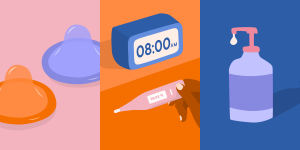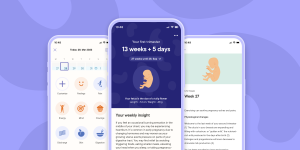Photo by Jen Bell
Thinking about pregnancy as a nonbinary trans person
“Good evening, ladies, gentlemen, and the rest of us.”
This was my opening line in a play that toured the world for years. In every city we played, most of the audience hated me for it and weren’t afraid to tell me. But “the rest of us” were living for it. And, of course, they were the ones I was speaking to with that line.
Later, when the show went to Broadway and Kate Bornstein took on that role, an audience member shouted up at them one night, “You’re not welcome here.” Kate’s response was, of course, generous and warm, welcoming this woman despite her ignorance. But it’s hard work to be expected to represent “the rest of us,” whether in such a public forum or just walking down the street. Every person’s story is different, and I can only share with you my own.
Hi. My name is Elliott. My pronouns are they/them. I have to come out endlessly as trans, as nonbinary, as queer, as not-every-trans-nonbinary-queer. I’ve been using the Clue app for about six months now, and I’m planning a pregnancy with my partner. Their pronouns are also they/them. Between the two of us, I’m the eligible gestational body.
As I explained it to my mom, my brother, my insurance navigator, and a handful of friends both new and old, between our two bodies, theoretically we’ve got the parts to make this happen.
When I first started using Clue, it was because I’d been experiencing seemingly random bleeding and spotting, despite having a Mirena IUD for about a year, and being on testosterone for six years. I have been so dissociated from my reproductive organs for so long that it just felt like a constant and unpredictable intrusion, until my partner started regularly observing the cycle of changes in my body.
I’d read about Clue a year earlier in LOLA magazine and had been reading Clue’s blog occasionally since then. So it was a no-brainer for me to choose Clue over any other apps. It helps that the design is fun and gender-inclusive.
Once I started tracking other symptoms—in addition to bleeding and spotting—in the app, such as, cervical fluid, skin, digestion, and energy levels, I was able to see that I actually do have a predictable cycle.
It also helped me differentiate between the cyclical spotting and breakthrough bleeding I was having, since they look similar.
After a few months of this, I began to actually feel a connection to these organs in my pelvis. And one day, out of the blue, I was struck with “puppy fever.” I had never wanted to be a parent, let alone a gestational parent before, but I think moving to a country with an affordable cost of living and no school shootings had allowed space for my feelings around parenting and pregnancy to shift.
I started researching, reaching out to other queer and trans parents, reading articles and studies and books. When it comes to trans health, the best resources are often a combination of one’s own intuition and the trans community. And the trans community often points to cis centered research to fill in the gaps, with advice to hold your nose. So with that advice, I borrowed Toni Weschler’s “Taking Charge of Your Fertility” from a friend and read the whole thing in one day.
There are so many steps before we can just “relax and let it happen,” as is commonly prescribed to straight-presenting, able-bodied, cisgender (non-trans) couples. And while it’s possible to get pregnant while on testosterone, it’s not common. And tracking my temperature along with my period has shown that my bleeding is anovulatory.
There’s not much research specific to ovulation in trans and gender-nonconforming people after stopping testosterone, but one small study showed that in 25 people who later became pregnant, 8 out of 10 of them began menstruating within 6 months (1). I’m a member of the Facebook group Birthing and Breast or Chestfeeding for Trans People and Allies, and group members have reported that it’s taken them anywhere from weeks to a year to start ovulating after going off testosterone.
There’s a lot more research to be done. I had top surgery three years ago, and while there are ways to induce milk production in both AMAB (Assigned Male at Birth) and AFAB (Assigned Female at Birth) people (2-7), I am not sure that’s the path for me. [A note from the Clue science team: In people who have had top surgery, breast or chestfeeding may not be possible, or it may be more difficult, depending on how the surgery was performed (8).]
And I haven’t decided what I’d do if it turns out that my partner and I can't conceive without extensive medical intervention. There are career and housing details to sort out. Later on, there are questions of what our kid will call us, and what name and pronouns we’ll use until they can tell us what they want to be called. There’s a whole new social transition ahead: puberty number three.
In the years since top surgery, I’ve been getting sideways glances in men’s locker rooms. Before that, I was getting sideways glances in women’s locker rooms.
Which room will I go to with my effeminate, masculine, pregnant body? Where will I swim? Will I have to wear a top because my “male” nipples will now be considered “female”? When I start going to doctors’ offices or yoga classes for pregnant people and I’m the only person there who doesn’t identify as a woman, what then?
There are not currently any trans-inclusive birthing centers or medical centers where I live, and there is a very binary idea of trans life among healthcare professionals here. Friends here in Germany who have had top surgery have been asked by their surgeons when they’ll be getting bottom surgery. My experience in the US is that there’s more flexibility and less pressure to undergo a “complete” surgical reconstruction.
According to recent research, pregnant trans people can feel hypervisible and/or invisible (9). I can’t go incognito as a cis woman because my body doesn’t look like that anymore. While there is some basic biological overlap, my social, emotional, and medical needs as a trans and nonbinary person will be different from cis people—starting even before conception, through gestation, during the birth, and long after as a parent.
I’m now two months off testosterone. I wanted to stop taking T early in this process because I was terrified that the physical changes caused by this hormonal shift would be too much for me. I was worried I’d change my mind about the whole thing.
Before T, I had no connection to my body. I didn’t want to lose the relationship I’ve built with it over the last six years.
But this pregnancy journey with my body is not a regression. Rather than losing what I’ve built, I’m connecting to my body in ways I never imagined I would as a trans person. I’m only at the beginning, but already this is a deep new level of connection. And it’s just going to get deeper.
Trans-friendly pregnancy resources
If you’re curious about reproductive options as a trans person, or you’d like support for your pregnancy, here are a few places to start:
Trans Pregnancy: Implications for Policy and Practice A poster from the 2018 WPATH (World Professional Association for Transgender Health) Symposium about trans pregnancy, made by Dr. Ruth Pearce.
Trans Pregnancy Project They often post great articles, studies, and other resources for trans people and health practitioners.
The Other Box: Parenthood A facebook group for parents and future parents who identify as “Other” in any way.
Birthing and Breast or Chestfeeding for Trans People and Allies A facebook group for trans and gender-nonconforming parents and potential/future parents and their allies.
Trans healthcare resource list by Serious Play Films A list of further resources for TGNC people curious about fertility and pregnancy, as well as resources for midwives, doulas, and other healthcare professionals.
Download Clue to track your ovulation and fertility.





